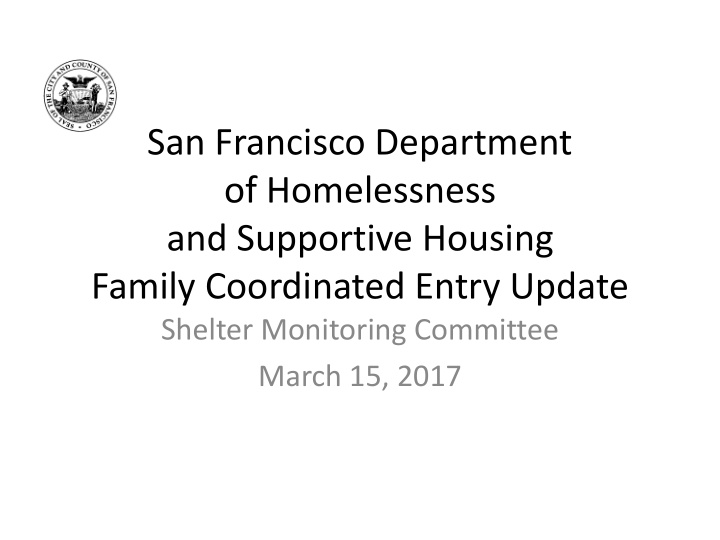



San Francisco Department of Homelessness and Supportive Housing Family Coordinated Entry Update Shelter Monitoring Committee March 15, 2017
What is Coordinated Entry? A process to connect people experiencing homelessness to the resources available in the community. A system that assesses the needs of the family and prioritizes them for a range of types of assistance, including immediate shelter and longer-term housing-focused programs.
Key Components of Coordinated Entry • Prioritization: Greatest needs receive priority for any type of housing and homeless assistance • Low Barrier: Programs lower their screening barriers • Housing First orientation: people are housed quickly without preconditions • Person-Centered: The coordinated entry process incorporates participant choice through assessment • Fair and Equal Access. people can easily access through well-known processes • Full coverage: Covers the entire geographic area. • Ongoing planning and stakeholder consultation: Feedback from individuals and families is regularly gathered and is used to improve the process • Informing local planning: Information gathered through coordinated entry guides planning and system change efforts • Safety planning. Protocols in place to ensure the safety of people seeking assistance • Homeless Management Information System (HMIS): Single community-wide data system used to collect and manage data associated with assessments and referrals • Source: https://www.hudexchange.info/resources/documents/Coordinated-Entry-Policy- Brief.pdf
What Coordinated Entry Will Not Do • Create new resources for homeless families • Create additional housing and shelter • Provide additional supportive services
Timeline 2015 - Now 2015 • Engaged Focus Strategies for Family Coordinated Entry design • Data gathering • System mapping • Stakeholder and Consumer Input 2016 • Family Coordinated Entry Consumer Feedback Report • Family Coordinated Entry Phase 1 Report • Analysis of Family Homeless System Data • Local Homeless Coordinating Board Family Coordinated Entry Meeting • Stakeholder and Consumer Input • Family Coordinated Entry Phase 2 Report • Department of Homelessness and Supportive Housing Established 2017 • Begin prioritization with shelter applicants • Local Homeless Coordinating Board Family Coordinated Entry Meeting
Data Available Number on San Francisco Family Shelter Waitlist Number on Priority Waitlist Date Number on WL WL 1/18/2017 207 59 1/4/2017 224 55 12/28/2016 236 54 12/21/2016 251 55 12/14/2016 251 55 12/7/2016 243 54 11/30/2016 251 53 11/23/2016 248 46 11/16/2016 244 50 11/9/2016 241 56 11/2/2016 252 55 10/26/2016 248 52
Data Available: Consumer Feedback Summary 1. Participants had to provide the same information multiple times (2-5 times), sometimes even with the same provider, and keep many appointments at different sites in order to access programs. Many forms were not provided in languages other than English. Participants were most appreciative of Compass ’ s ability to provide food, diapers, transit 2. passes and had inconsistent experiences with accessing housing or shelter with Connecting Point. 3. Several participants were not referred to Connecting Point by shelter or other program staff members, and instead learned about it through word of mouth. 4. Once sheltered, most participants said there was little consistent, up-to-date information about next steps and avenues for housing post-discharge. 5. Participants expressed a strong desire for better coordination 6. Homeless families expressed a great deal of anxiety about the search for permanent housing. 7. Many participants felt the system did not offer equal treatment. Most felt or observed that support varied depending on the experience and energy of the assigned case worker or the favoritism of staff 8. When starting over with a new case worker, much information had to be re-shared. Source: http://sfgov.org/lhcb/sites/default/files/San%20Francisco%20Family%20Coordinated%20Entry%20Consumer%20Feedback%20Report.pdf
System Map
Recommend
More recommend